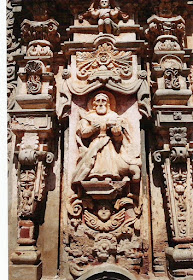However, the distant plain of southern Puebla, known regionally as la mixteca poblana, seems an unlikely place to find this decorative example of the late Pueblan baroque. Although the parish church of San Pedro Tecomatlán dates back to 1500s, it was substantially rebuilt in the latter years of the 18th century, and fitted with an elaborate facade in the still fashionable Mexican Churrigueresque style.
San Pedro Tecomatlan facade before and after recent restoration
The FacadeAlthough the architect and source of funding for this ornate church front is so far unknown, the facade is remarkable for its profusion of statuary and relief ornament in a popular folk idiom. The decorative center facade is framed by its two pairs of elaborate estípites, decorated with herms and grotesque masks. Prominent niche-pilasters (interestípites) in carved stone and modeled stucco feature the statues of the Four Evangelists, housed in swagged niches complete with their associated symbols, and quill pens held aloft.
A naive, frontal figure of St. Peter (San Pedro) rests in a plain niche over the doorway. Above the "bulls-eye" choir window, a group of flying angels in 16th century style surround a curtained upper niche which contains another small statue. A pair of large, naked atlantes support the crowning gable. Every element is densely ornamented with delirious swirls of vegetation & scrollwork.
 |
| St Mark |
 |
| St Matthew |
Text © Richard D. Perry 2005/2019
Color images ©2004 Felipe Falcón, by special permission.
Please review our earlier posts on the folk baroque churches of Puebla: San Jeronimo Aljojuca; Santa Inez Xanenetla; Tlancualpican; Santa Ana Jolalpan; Santa Maria Jolalpan; San Simón Quecholac; San Pablo de Las Tunas;
Please review our earlier posts on the folk baroque churches of Puebla: San Jeronimo Aljojuca; Santa Inez Xanenetla; Tlancualpican; Santa Ana Jolalpan; Santa Maria Jolalpan; San Simón Quecholac; San Pablo de Las Tunas;




No comments:
Post a Comment